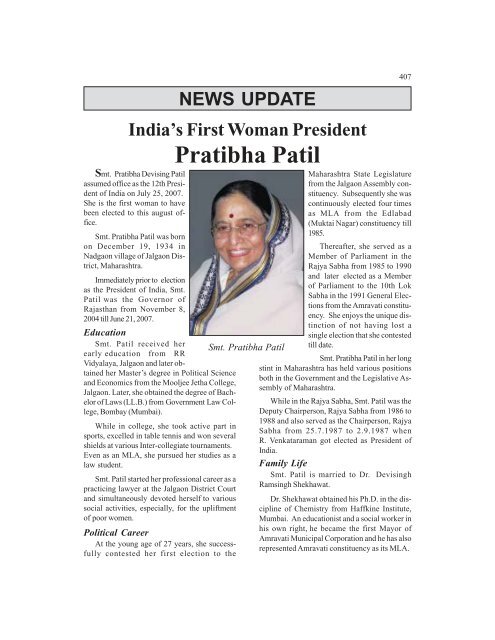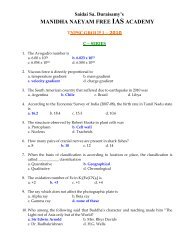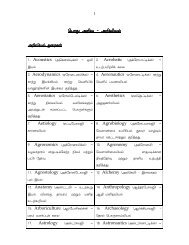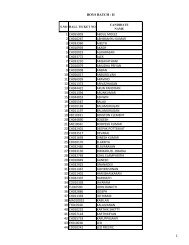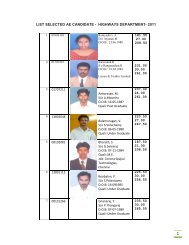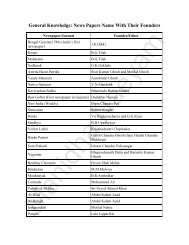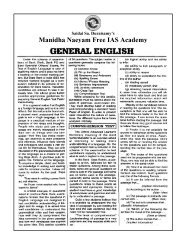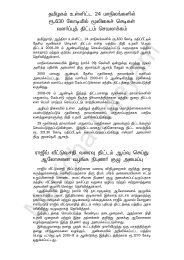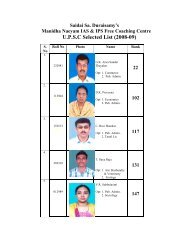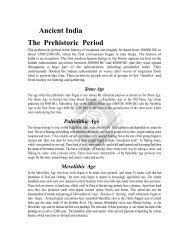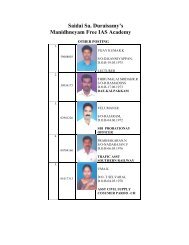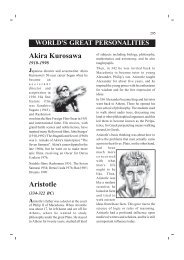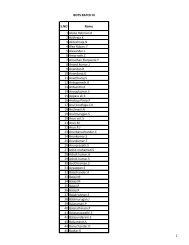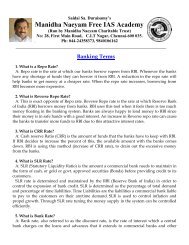You also want an ePaper? Increase the reach of your titles
YUMPU automatically turns print PDFs into web optimized ePapers that Google loves.
Smt. <strong>Pratibha</strong> Devising <strong>Patil</strong><br />
assumed office as the 12th President<br />
of India on July 25, 2007.<br />
She is the first woman to have<br />
been elected to this august office.<br />
Smt. <strong>Pratibha</strong> <strong>Patil</strong> was born<br />
on December 19, 1934 in<br />
Nadgaon village of Jalgaon District,<br />
Maharashtra.<br />
Immediately prior to election<br />
as the President of India, Smt.<br />
<strong>Patil</strong> was the Governor of<br />
Rajasthan from November 8,<br />
2004 till June 21, 2007.<br />
Education<br />
Smt. <strong>Patil</strong> received her<br />
early education from RR<br />
Vidyalaya, Jalgaon and later obtained<br />
her Master’s degree in Political Science<br />
and Economics from the Mooljee Jetha College,<br />
Jalgaon. Later, she obtained the degree of Bachelor<br />
of Laws (LL.B.) from Government Law College,<br />
Bombay (Mumbai).<br />
While in college, she took active part in<br />
sports, excelled in table tennis and won several<br />
shields at various Inter-collegiate tournaments.<br />
Even as an MLA, she pursued her studies as a<br />
law student.<br />
Smt. <strong>Patil</strong> started her professional career as a<br />
practicing lawyer at the Jalgaon District Court<br />
and simultaneously devoted herself to various<br />
social activities, especially, for the upliftment<br />
of poor women.<br />
Political Career<br />
At the young age of 27 years, she successfully<br />
contested her first election to the<br />
NEWS UPDATE<br />
India’s First Woman President<br />
<strong>Pratibha</strong> <strong>Patil</strong><br />
Smt. <strong>Pratibha</strong> <strong>Patil</strong><br />
407<br />
Maharashtra State Legislature<br />
from the Jalgaon Assembly constituency.<br />
Subsequently she was<br />
continuously elected four times<br />
as MLA from the Edlabad<br />
(Muktai Nagar) constituency till<br />
1985.<br />
Thereafter, she served as a<br />
Member of Parliament in the<br />
Rajya Sabha from 1985 to 1990<br />
and later elected as a Member<br />
of Parliament to the 10th Lok<br />
Sabha in the 1991 General Elections<br />
from the Amravati constituency.<br />
She enjoys the unique distinction<br />
of not having lost a<br />
single election that she contested<br />
till date.<br />
Smt. <strong>Pratibha</strong> <strong>Patil</strong> in her long<br />
stint in Maharashtra has held various positions<br />
both in the Government and the Legislative Assembly<br />
of Maharashtra.<br />
While in the Rajya Sabha, Smt. <strong>Patil</strong> was the<br />
Deputy Chairperson, Rajya Sabha from 1986 to<br />
1988 and also served as the Chairperson, Rajya<br />
Sabha from 25.7.1987 to 2.9.1987 when<br />
R. Venkataraman got elected as President of<br />
India.<br />
Family Life<br />
Smt. <strong>Patil</strong> is married to Dr. Devisingh<br />
Ramsingh Shekhawat.<br />
Dr. Shekhawat obtained his Ph.D. in the discipline<br />
of Chemistry from Haffkine Institute,<br />
Mumbai. An educationist and a social worker in<br />
his own right, he became the first Mayor of<br />
Amravati Municipal Corporation and he has also<br />
represented Amravati constituency as its MLA.
408<br />
Benazir Bhutto Assassinated<br />
(27-12-2007)<br />
Benazir Bhutto, 54,<br />
Chairperson of the Pakistan<br />
People’s party, was killed in<br />
a gunfire attack – cum- suicide<br />
bombing minutes after<br />
she finished addressing an<br />
election really at Rawalpindi<br />
on 27-12-2007.<br />
Ms. Bhutto had descended<br />
the stage at Liaquat<br />
Bagh, the venue of the rally,<br />
and got into a waiting car<br />
behind the stage. The vehicle,<br />
accompanied by several<br />
other escort cars with<br />
her supporters and PPP<br />
bodyguards, was leaving the<br />
venue when the explosion<br />
took place, about 5-20 PM.<br />
Benazir was critically<br />
injured in the attack and her<br />
car took her to the<br />
Rawalpindi General Hospital.<br />
There doctors battled to<br />
save her about 40 minutes. At 6-15 PM, doctors<br />
announced that Benazir was dead.<br />
Benazir’s father Zulfiquar Ali Bhutto, was<br />
the Prime Minister of Pakistan during 1971 to<br />
1977.<br />
On 5 th July 1977 a military<br />
coup occurred against<br />
Bhutto and Army Genneral<br />
Zia-ul-hug captured the<br />
power.<br />
Despite an international<br />
clamour for clemency,<br />
Bhutto was hasily executed<br />
on 4 April 1979 at<br />
Rawalpindi Central Jail.<br />
The eldest of Bhutto’s<br />
Benazir Bhutto with family<br />
Zulfiquar Ali<br />
Bhutto<br />
four children, Benazir was<br />
educated at Harvard and<br />
Oxford Universities. She<br />
married Asif Zardari in July<br />
1987.<br />
Gen Zia was killed following<br />
the crash of his air<br />
craft on 17 th August 1988.<br />
In the general election<br />
which as held in December<br />
1988, Benazir win and became<br />
the first women<br />
Prime Minister in Islamic<br />
World. But her government<br />
was short-lived, collapsing<br />
in 1990 on charge<br />
of corruption. In 1993,<br />
Benazir was returned to<br />
office to head a coalition<br />
government, which was<br />
again dismissed, in 1996,<br />
on grounds of corruption.<br />
Then she was living in<br />
western countries with her<br />
family.<br />
Benazir returned to Pakistan on 18-10-2007<br />
from eight years of self-imposed exile to participate<br />
in the general election.<br />
On the next day, a procession was held in<br />
Karachi welcoming Benazir. At that time an assassination<br />
attempt by<br />
bomb blasts took place<br />
which killed 139 people but<br />
Benazir escaped.<br />
But, in their second attack<br />
the terrorists killed<br />
Benazir.<br />
After Benazir’s death,<br />
her 19 year old son Bilawal<br />
Asif Zardari Bhutto Zardari is named<br />
PPP Chairman.
Guru Nanak<br />
409<br />
Sikhism founded on the teachings of<br />
Nanak and nine successive gurus in fifteenth<br />
century Northern India, is the fifthlargest<br />
organised religion in the world This<br />
system of religious philosophy and expression<br />
has been traditionally known as<br />
the Gurmat (literally the counsel of the<br />
gurus) or the Sikh Dharma.<br />
The principal belief of Sikhism is faith<br />
in Vâhigurû—represented using the sacred<br />
symbol of çk ôaEkâr, the Universal<br />
God. Sikhism advocates the pursuit of<br />
salvation through disciplined, personal<br />
meditation on the name and message of<br />
God. A key distinctive feature of Sikhism<br />
is a non-anthropomorphic concept of God,<br />
to the extent that one can interpret God as the<br />
Universe itself.<br />
Sikhism’s traditions and teachings are distinctively<br />
associated with the history, society and<br />
culture of the Punjab. Adherents of Sikhism are<br />
known as Sikhs and number over 23 million across<br />
the world. Most Sikhs live in the state of Punjab<br />
in India and, prior to the country’s partition, millions<br />
of Sikhs lived in what is now known as the<br />
Punjab province of Pakistan.<br />
Guru Nanak Dev Birth and early life<br />
Sri Guru Nanak Dev Ji was born 20 October<br />
1469 into a Hindu Khatri family, in the village of<br />
Rai Bhoi Ki Talwandi, now called Nankana Sahib<br />
(after the Guru), near Lahore, Pakistan. Today,<br />
his birthplace is marked by Gurdwara Janam<br />
Asthan.<br />
His father, Kalidas Chandarana, later known<br />
as Kalyan Das Bedi, also known as Mehta Kalu<br />
was the patwari (accountant) of crop revenue<br />
for the village of Talwandi under the Muslim landlord<br />
of the village, Rai Bular, who was responsible<br />
for collecting taxes. Guru Nanak’s mother<br />
was Tripta Devi and he had one older sister,<br />
Nanaki.<br />
After Nank’s birth, an astrologer who came<br />
Guru Nanak<br />
to write his horoscope insisted on seeing the<br />
child. On seeing the infant, he is said to have<br />
worshipped him with clasped hands.<br />
At the age of five years Nanak is said to have<br />
voiced interest in divine subjects. At age seven,<br />
his father Mehta Kalu enrolled him at the village<br />
school as per the norm. Notable lore reccounts<br />
that as a child Nanak astonished his teacher by<br />
describing the implicit symbolism of the first letter<br />
of the alphabet, which is almost straight stroke<br />
in Persian or Arabic, resembling the mathematical<br />
version of one, as denoting unity or oneness<br />
of God. Other childhood accounts refer to<br />
strange and miraculous events about Nanak such<br />
as a poisonous cobra being seen to shield the<br />
sleeping childs head from the harsh sunlight.<br />
Marriage and family life<br />
Guru Nanak was married to one Sulakhni. His<br />
marriage took place with her in the town of Batala.<br />
The marriage party had come from the town of<br />
Sultanpur Lodhi. He had two sons from this marriage;<br />
Sri Chand and Lakhmi Chand. The former<br />
was a deeply spiritual person and founded a<br />
renunciate/ascetic subsect known today as<br />
Udasis. The younger son grew up to become<br />
immersed in worldly life.<br />
Nanak’s teachings come down today
410<br />
foremostly in the Guru Granth, a vast collection<br />
of revelatory verses recorded in sloaks.<br />
From these some common principles seem<br />
discernable. Firstly a supreme Godhead who although<br />
incomprehensible manifests in a variety<br />
of religious forms, the Singular ‘Doer’ and formless<br />
source of all forms. It is described as the<br />
industructable or timeless form and in both impersonal<br />
and personal forms. Salvation or liberation<br />
depends on the grace (‘nadir’- glance) of<br />
God alone and although outside the power of<br />
the individual, manifests through the individual<br />
whom is seen to be unceasing in their efforts.<br />
Religious awakening is compared to undergoing<br />
a living death.<br />
Nanak describes the dangers of the self<br />
(haumai- ‘I am’) and calls upon devotees to engage<br />
in worship through God’s name and singing<br />
of God’s qualities, discarding doubt in the<br />
process. However such worship must be selfless<br />
(seva)- which could be said to be similar in<br />
principle to the nishkaam worhsip elaborated in<br />
the Bhagavad Gita.<br />
Guru Nanak in Mecca<br />
For over twenty years beginning about 1497,<br />
Guru Nanak traveled by foot throughout<br />
Hindustan. He traveled as far east as Assam and<br />
Burma. To the South he went as far as Sri Lanka<br />
(Ceylon). To the north he ventured even to<br />
places outside India like Tibet and China.<br />
He went towards the west to visit Muslim<br />
countries. He chose Mecca as the first such place<br />
to visit.<br />
Last years of Nanak<br />
As his end approached Nanak would frequently<br />
test the devotion of his sons and nearest<br />
followers and in doing so demonstrate their<br />
state of mind to one another. There were numerous<br />
such occasions and one particular devotee,<br />
Lehna, rose to eminence because he never faltered<br />
in his faith in Nanak.<br />
Nanak proclaimed Lehna as the successor<br />
Guru, renaming him Angad, meaning ‘limb’ or<br />
‘ones very own’. This successorhood wasnot a<br />
mere gesture. Via a transformation, compared in<br />
Sikh tradition as the passing of a flame from one<br />
candle to another, the Guru-aspect of Nanak descended<br />
upon Angad. Angad became Nanak. In<br />
the Guru Granth this is described as having even<br />
a physical manifestation whereby Angad in person<br />
suddenly appeared to look like Nanak.<br />
(To sikhs, although there were ten separate<br />
Gurus in physical form, there was actually only<br />
one single Guru whose metamorphosised light<br />
moved from one successor or vessel to the next,<br />
granting a kind of rebirth to those personalities<br />
on their initiation. Hence they all held the original<br />
name of Nanak.)<br />
Shortly after proclaiming Lehna as the next<br />
Guru, Nanak announced that his death had arrived,<br />
and retreated to a tree whereby he sat in<br />
the lotus position and the praan (life-force) was<br />
guided upwards and liberated from his body. The<br />
date was said to be 22 September 1539 according<br />
to the western calender.<br />
Golden Temple


